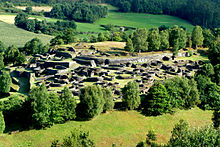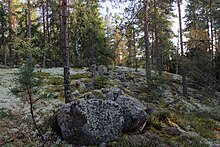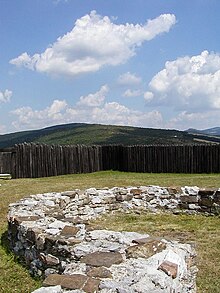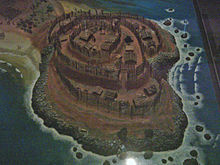Hillfort
A hillfort is a type of fortified refuge or defended settlement located to exploit a rise in elevation for defensive advantage.The fortification usually follows the contours of a hill and consists of one or more lines of earthworks or stone ramparts, with stockades or defensive walls, and external ditches.Where Roman influence was less strong, such as uninvaded Ireland and unsubdued northern Scotland, hillforts were still built and used for several more centuries.[13] Cadbury Castle, Somerset is the largest amongst forts reoccupied following the end of Roman rule, to defend against pirate raids, and the Anglo-Saxon invasions.For example Offa's Dyke, a linear earthwork generally dated to the 9th century CE, makes use of the west and south-west ramparts of Llanymynech hillfort.[17] The Wansdyke was a new linear earthwork connected to the existing hillfort at Maes Knoll, which defined the Celtic-Saxon border in south-west England during the period 577–652 CE.King Alfred established a network of coastal hillforts and lookout posts in Wessex, linked by a Herepath, or military road, which enabled his armies to cover Viking movements at sea.These would have been important tribal centres where the chief or king of the area would live with his extended family and support themselves by farming and renting cattle to their underlings.One must be careful to not confuse a hill-fort with a 'ringfort'—a medieval settlement—a common archaeological feature across the whole island of Ireland, of which over 40,000 examples are known;[21] one source claims there may be 10,000 undiscovered ringforts.[22] In Galicia, Asturias, Cantabria, Basque Country, province of Ávila and Northern Portugal a castro is a fortified pre-Roman Iron Age village, usually located on a hill or some naturally easy defendable place.Many of the megaliths from the Bronze Age such as menhirs and dolmens, which are frequently located near the castros, also pre-date the Celts in Portugal, Asturias and Galicia as well as in Atlantic France, Britain and Ireland.The Celtiberian people occupied an inland region in central northern Spain, straddling the upper valleys of the Ebro, Douro and Tajo.Hillforts with strong walls are often located beside old trade routes and have an offensive character, whereas others are reclusive and were weakly fortified, probably only for hiding during raids.Many forts, located centrally in densely populated areas, were permanently settled strongholds and can show traces of settlements both inside and outside.Latvian hillforts generally were a part of a complex consisting of the main fortress, the settlement around it, one or more burial fields and nearby ritual sites.Most of these forts were built or expanded between the fifth and fifteenth centuries, when they were used in the Dukes' Wars, and against the invasion of Teutonic Knights from the west.During the early years of Grand Duchy of Lithuania piliakalniai played a major role in conflicts with the Livonian Order and the Teutonic Knights.In the Philippines, the Ivatan people of the Batanes Islands built ijang—fortified villages on top of natural hills and raised landforms near the coastlines.During the Spanish colonial era, ijang were abandoned during the Reducciones as the Ivatan population were moved into centralized towns in the lowlands.Traditional pā took a variety of designs, ranging from a simple terraced hill, to complex fortified structures that include multiple rows of palisades and underground defensive and ambush points.Māori pā differed from European hillforts in that they also prominently incorporate food storage pits and often, water sources.








Maiden CastleMajor George AllenoutlineHistoryPrehistoricAncientPost-classicalCastlesEarly modernMilitary revolutionPike and shotNapoleonic warfareLate modernIndustrial warfareFourth-gen warfareMilitaryOrganizationCommand and controlDefense ministryAir forceMarinesCoast guardSpace forceReservesEngineersMedicalPoliceDivingInfantryCavalryArtillerySpecial forcesSignal corpsWarshipsSubmarinesAircraft carriersLanding craftAuxiliary shipsFightersBombersCommandClose air supportElectronic-warfareReconnaissanceFire-control systemFire-control radarDirector (military)Combat information centerShip gun fire-controlGun data computerTorpedo data computerBasic trainingMilitary manoeuvrersCombat trainingBattlespaceAerospaceAerialAirborneCold-regionDesertFortificationJungleMountainSubterraneanTunnelAmphibiousSurfaceUnderwaterSeabedInformationWeaponsAir defenceBarrageBiologicalCamouflageHorsesChemicalCombined armsConventionalDenialDisinformationElectromagneticLoiteringMissileNuclearPsychologicalRadiologicalSubmarineUnconventionalTacticsList of military tacticsAirliftAir assaultAirbridgeAirdropAnti-aircraftAnti-subAnti-tankBattleChargeCounterattackCounterinsurgencyConvoyDefeat in detailFoxholeEnvelopmentFormationGuerrillaRapid dominanceEncirclementInvestmentScreenTactical objectiveTarget saturationTrenchWithdrawalOperationalMilitary operationSpecialOperations researchBlitzkriegExpeditionaryDeep operationManeuverOperational manoeuvre groupCovert


